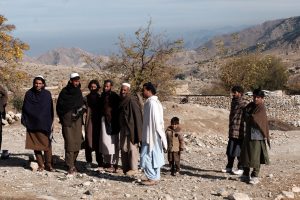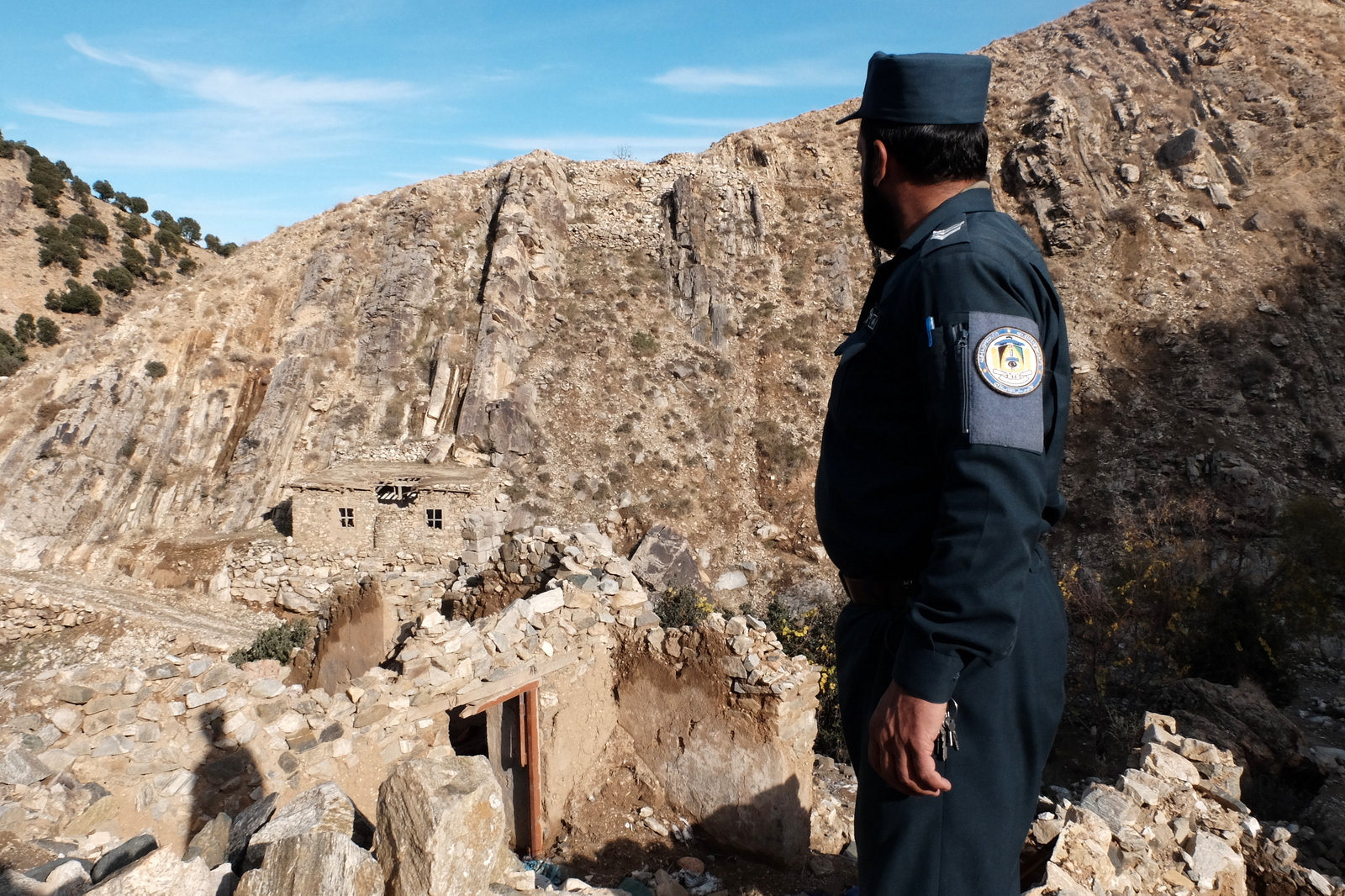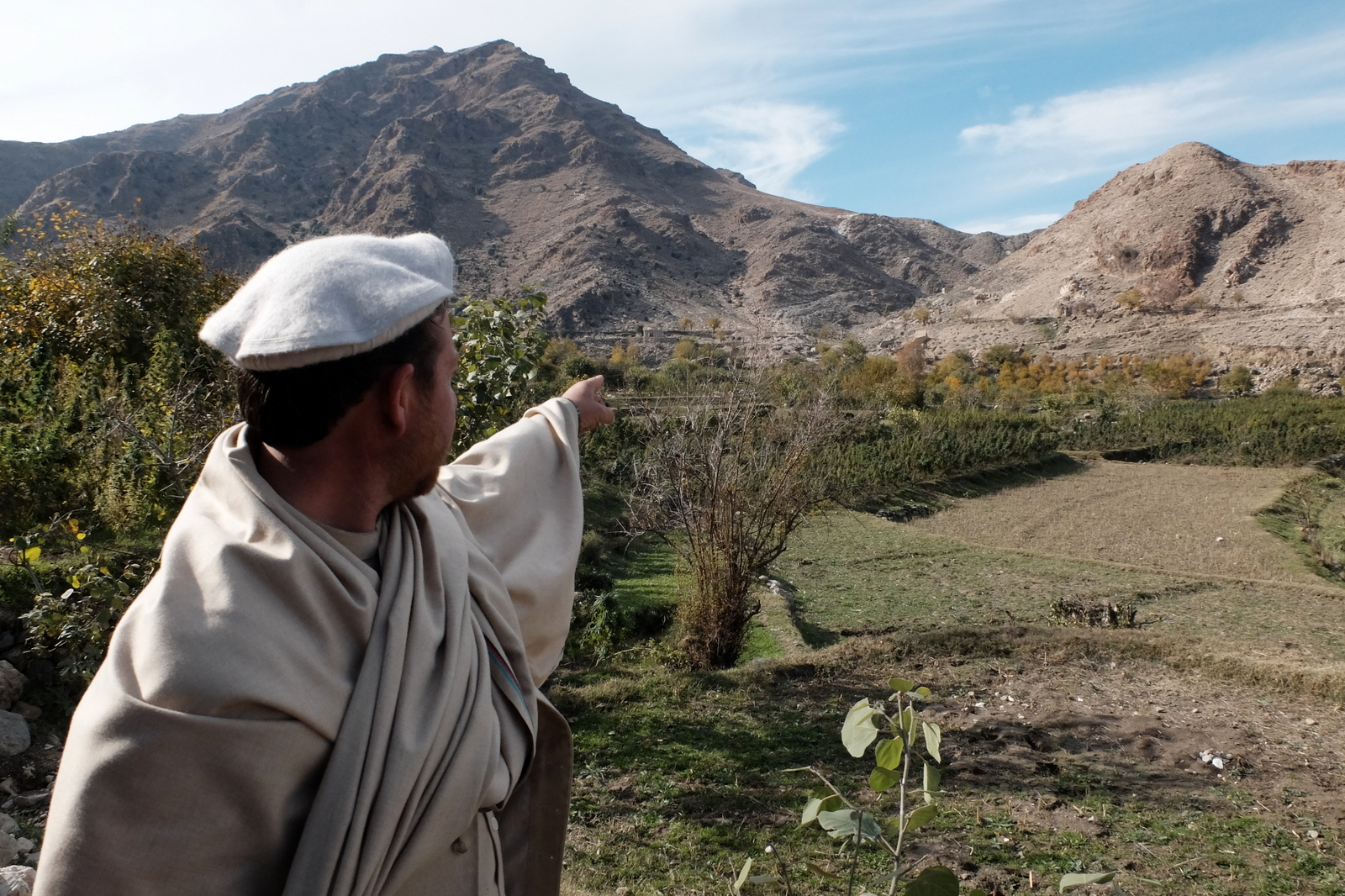By Giuliano Battiston
 MAMAND VALLEY, ACHIN DISTRICT, NANGARHAR – “It was four years ago, more or less. They approached me carrying long swords and heavy weapons and told me: ‘You have 10 minutes to leave your home. If you don’t, your head is gone.’ I was not allowed to bring with me even a handful of soil.”
MAMAND VALLEY, ACHIN DISTRICT, NANGARHAR – “It was four years ago, more or less. They approached me carrying long swords and heavy weapons and told me: ‘You have 10 minutes to leave your home. If you don’t, your head is gone.’ I was not allowed to bring with me even a handful of soil.”
Zarlal is a 45-year-old farmer who lives in Mandatay, a small village of just a few homes, most of them fully destroyed or partly collapsed, at the far end of Mamand Valley, in the Achin district. Approximately 50 kilometers south of Jalalabad city, in the south of Afghanistan’s key eastern province of Nangarhar, the district borders the tribal areas on the Pakistani side of the Durand Line.
To access Mamand Valley takes a long trip on an unpaved, rough road surrounded by a spectacular environment, mostly dominated by the Spin Ghar mountain range. Since 2015, this highly mountainous, rugged, and extremely isolated terrain has been the main stronghold of the Islamic State Khorasan Province (ISKP), the local branch of the radical, Islamist group.
According to the Afghan government, ISKP (generally referred to in Afghanistan as Daesh) has been completely dislodged from Nangarhar province after a 7 week-long military operation that took place in late 2019. Residents like Zarlal have indeed started to return to their homes, but ISKP’s legacy still looms large, and the security situation is fragile.
“Look at my hands,” Zarlal says, turning up his palms. “I’ve worked four months to rebuild the house on my own. It was completely demolished due to the fight. We have lived in refugee camps for years and were able to re-enter our house one month ago.”
Zarlal confirms that the surroundings are safer now, but fears are still there, worsened by the lack of basic services. “We need to rebuild so many things. They say that Daesh is over, but the security is not granted at all. Up to that mountain there’s a checkpoint for the uprising forces, but they need more equipment. Some places cleared of Daesh, like Dago Mina, are now occupied by the Taliban,” he says.
Commander Abasin, a nom de guerre, leads one of the so-called popular forces, or uprising civilian groups, the militias run and financed by the National Directorate of Security (NDS), the country’s intelligence agency. “I was a member of the local police, then I was given the charge of the uprising ‘station.’ We severely fought for two years against Daesh and the Taliban. And we will continue to defend our land at the cost of lives. But we need weapons, coordination, support. And money: over the last three months we did not receive salaries at all,” he complains.
Conflict is a dramatic constant with Achin and especially with Mamandis, the residents of this valley. Heavily fought over for roughly four years by the Taliban, ISKP, Afghan and U.S. forces, Achin district has been affected by civilian losses and casualties, material devastation, major displacements, and returns.

A policeman shows some houses destroyed during the clash with Daesh. Photo by Giuliano Battiston.
“Five years ago they [ISKP forces] moved into our villages with their families from three directions, Pekha Valley, Kot and Deh Bala districts,” recalls Amin Hazimi, a Shinwari tribal leader and malik of Mamand Bagh, another village in Mamand Valley. “We were told that they were escaping violence from the Pakistani authorities, that they were muhajerin [refugees].” The residents of Mamand Bagh welcomed them “according to Pashtunwali,” the Pashtun people social code, “but soon we found ourselves under an extremely harsh rule.”
The Achin district, among others, was captured in early 2015 by a group of Pakistani militants, mostly from the Pakistani Orakzai, North Waziristan, and Khyber Tribal Agencies, followed by other fighters from the Afghan provinces of Kunar and Laghman. “They chose Mamand Valley because it is easy to defend and extended enough to host training camps and depots,” Antonio Giustozzi, author of The Islamic State in Khorasan, explained to The Diplomat. Furthermore, “it was home in 2014-15 to TTP, the Pakistani Taliban fighters who were looking for a new patron and found it in Daesh,” he adds.
At that time, Nangarhar’s militant landscape was not fully controlled by the Afghan Taliban, and many Salafi fighters felt attracted by the sectarianism invoked by ISKP members, who claimed to fight for a purer creed than the Hanafi one — the Islamic school of thought most common among the Taliban and disregarded as impure by the Islamic State.
DIPLOMAT BRIEF
WEEKLY NEWSLETTERN
Get first-read access to major articles yet to be released, as well as links to thought-provoking commentaries and in-depth articles from our Asia-Pacific correspondents.SUBSCRIBE NEWSLETTER
Within months of their arrival, ISKP militants became more and more demanding, increasingly predatory, and harsher in their rules. “They told us that there was no alternative to the Caliphate. They stole every freedom from us in the name of Islam, but Daesh members are not truly Muslims. They behaved so cruelly, while Islam forbids cruelty. Daesh does not represent Islam,” malik Amin Hazimi emphasizes.
The men surrounding him agree, shaking their hands. Some list the atrocities committed by ISKP: burned houses, closed schools, forced marriages, murders. “We suffered a lot. We count many orphans, many widows. Some villagers were killed by blasts so powerful that there were no remains. We could not provide them proper graves,” mourns Hazimi. He takes pride in the resistance of the village: “In 2015 we rose up against Daesh, we killed 335 of them, but the government did not help us and we had to leave. We came back some months ago, but many families are not here yet.”

Malik Amin Hazimi tells the story of life during and after Daesh. Photo by Giuliano Battiston.
“Our houses were confiscated by Daesh and we had to live faraway for four years,” recalls Razab Gul, a 40-year-old man from Bizo Dag, the third village we visit in Mamand Valley. “They used to fight from there, behind the mosque, up to the hills,” he remembers, pointing at one side of the mountain, whitened by a streak of talc.
Given its location, Achin district is a key transit point for weapons, fighters, and narcotics, and is also rich with mineral and natural resources. It has been estimated to hold 1.25 million tons of talc and has deposits of chromite and magnesite as well. “Daesh selected this area because of the money: here you have iron and other minerals. And you also have shawqanai: pine nuts give back good money!” Razab Gul states.
Jalal, a 60-year-old resident, claims that out of 1,000 families once living in the village “only 600 are back.” Old issues are exacerbated by new ones, related to the ISKP’s legacy. “We have no doctors, no clinic, no school. The kids do their lessons in open air. There’s no paved road, no clean water, no dam to foster agriculture. Many houses are destroyed, and you may still find mines in the fields.”
Will Daesh be back? “I don’t know,” Razab Gul replies. “It all depends if the government will support us or not.”
Shafiqullah Sadat, Achin district governor, has no doubts. “Thanks to Allah, the military operation was totally successful. We now hold and control the whole district. The defeat of Daesh is definitive, yes.”
The “definitive operation” is the latest in a long series of military initiatives carried out by the Special Forces of the Afghan National Army, Afghan Local Police, Afghan Border Police, and the so-called uprising militias, with U.S. support, who provided special troops and crucial air support. The campaign intensified in 2019. These forces have been engaged in offensive operations against ISKP several times, and the Taliban intensified the battle as well, considering ISKP a dodgy competitor with a global jihadist vision opposite their nationally-oriented one.
However, the gains of the Afghan forces were never lasting or conclusive. Control of the district always remained precarious and unstable, even after U.S. President Donald Trump on April 13, 2017 authorized the dropping of an 11-ton Massive Ordnance Air Blast (MOAB) bomb, the largest non-nuclear bomb ever used in combat. The so-called Mother Of All Bombs targeted the ISKP complex of tunnels and caves in Mamand Valley, but did not succeed in dislodging the militants. “The bomb was dropped over there, between those two mountains where you see black soil, turned black due to the explosion,” Sharifullah, a resident of Shadal Bazar, tells The Diplomat. “The bomb destroyed dozens of poor houses, made several victims, but Daesh resisted for two more years,” he recalls showing the impact of MOAB in Asadkheil village.

Sharifullah, a resident of Shadal Bazar, points at the place where MOAB was dropped. Photo by Giuliano Battiston.
Despite some setbacks and reduced territorial control, ISKP was able to maintain its strongholds in Mamand Valley until a few weeks ago. “This time it’s different,” avers Achin governor Sadat, who argues that “the success heavily depends on local factors: the uprising forces.” According to the numbers he provides, “1,000 members of the uprising forces, 200 provided by National Army and by the Police Border Police, plus the national and international air forces” contributed to the operation. It started “during the period of mizam 1398,” in September/October 2019, “when a local revolt against Daesh erupted in Bandar Dara, and lasted 45 days.”
Bandar Valley was “the core of the Khorasan project. Daesh established its coordination and prayer center there. Every military operation within Afghanistan was planned there. Every single suicide attacker was trained and equipped there. Its radio, Khilafat Ghag,” the Voice of Caliphate, “was there. Now, everything is gone.”
From one place to another, from one valley to the next, Sadat recounts, “the operation spread all over the district. The food, clothes, weapons, and militants’ supply routes were blocked in advance. They had just two options: to be killed or to surrender.”
Outside of the governor’s office – basically a room furnished with pillow, carpets, a bed, and a wardrobe in a two-story building — sit a dozen of those who surrendered. Most of these ISKP fighters, with long hair, tired faces, and listless eyes, suffer deep wounds; some have crutches and bandaged arms. “It’s the price of war,” snickers one of the guards who monitor them.
The governor extracts a few papers from under the carpet. It’s the list of fighters who recently surrendered. “More than 700 in just a few days,” he recalls enthusiastically. “There are Afridis from both the sides of the border, Afghans from Kunar province, citizens of Iran, Uzbekistan, Turkmenistan, Chechnya, India, some Arabs. The majority are from Orazkai agency, in Pakistan,” he reads.
“Daesh is defeated,” says the governor of Achin district. Photo by Giuliano Battiston.
Their destiny is unclear, as are the fates of their children and wives, who capitulated with them. “There are three main groups within Daesh: the Afghan fighters, the foreigners and those – whom we consider Afghans as well — who belong to Pakhtunkhwa,” the northernmost province of Pakistan, formerly the North-West Frontier Province, Attaullah Khogyani, the Nangharar’s governor spokesperson, explains to The Diplomat. “We provide shelter, food and medical care to each one. Afghans will be treated according to our law; children and women from Pakhtunkhwa are handed over to tribal elders and ulema on the other side of the Durand Line. Foreigners will be judged according to international law and diplomatic agreements,” he says.
In late November 2019, Afghanistan’s President Ashraf Ghani claimed complete victory over ISKP in Nangarhar. Khogyani confirms this. “As a military group, Daesh is fully defeated here. There should be some individual fighters, isolated. Not a worry.” The Taliban played a role in defeating ISKP, he admits. However, “they are not strong enough to overwhelm Daesh by their own.” He still considers the Taliban “as enemies.”
With the prospects of a political deal between the United States and the Taliban within reach, some analysts fear that, despite ISKP’s setbacks, disgruntled militants — those displeased by the peace process or doomed not to benefit from it — may still align themselves with ISKP. That possibility is confirmed by Antonio Giustozzi: “Daesh has already worked on it. This is what Daesh hoped and one of the reasons why Mullah Haibatullah Akhundzada,” the supreme leader of the Taliban, “decided to move against Daesh decisively. If Daesh is too weak, it cannot attract many Taliban,” Giustozzi says.
Khogyani, the governor’s spokesperson, is less nuanced: “Daesh is a foreign group, imposed on us by external actors. The Taliban have some foreign financial support, but the core leadership is Afghan. As long as the fight is on, we will fight them. But we are ready to welcome them back into our common society,” he states in his office in Jalalabad, the provincial capital. “After the deal, there will be no Taliban shifting to Daesh, because Daesh is already over.”
Giuliano Battiston is an Italian freelance journalist and researcher who regularly covers Afghanistan.
No comments:
Post a Comment